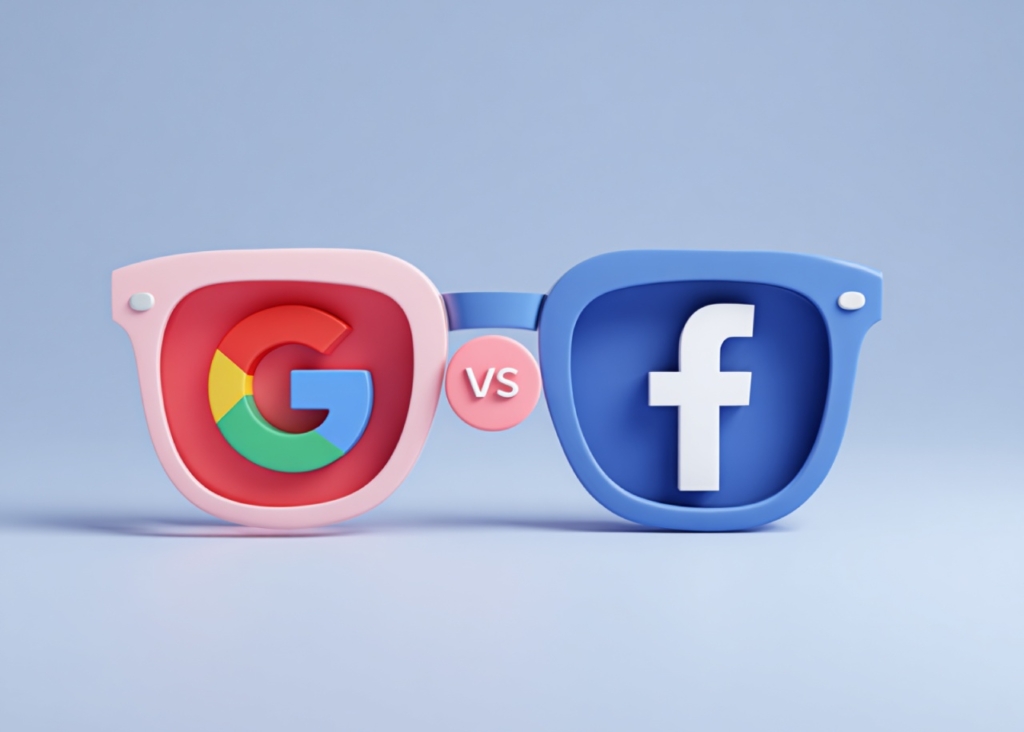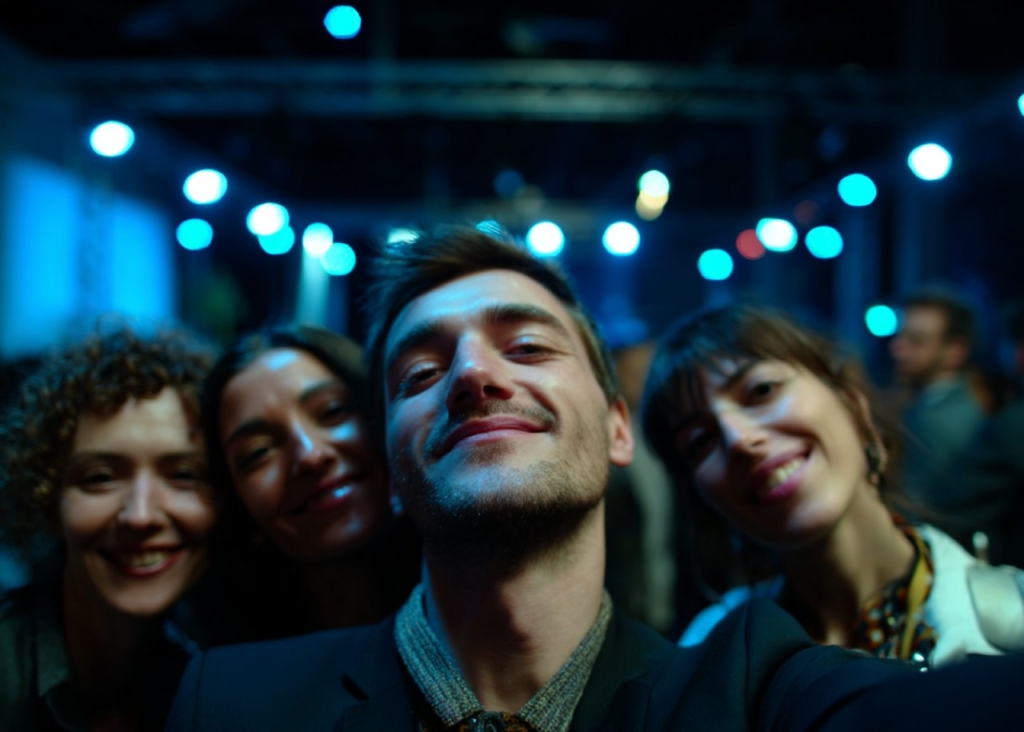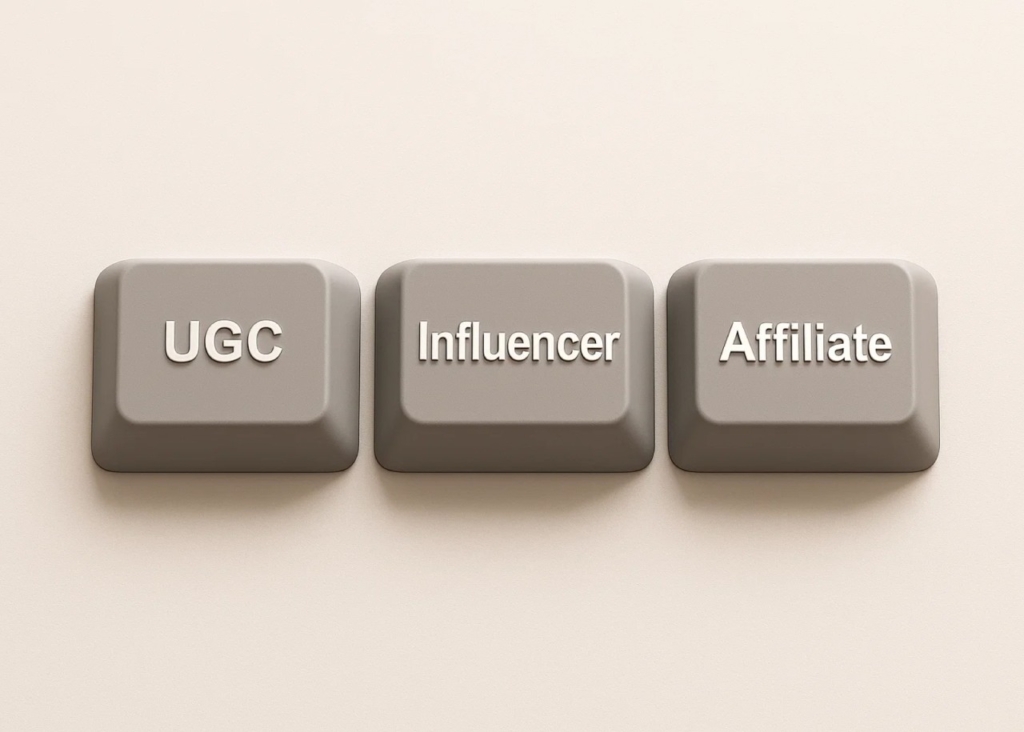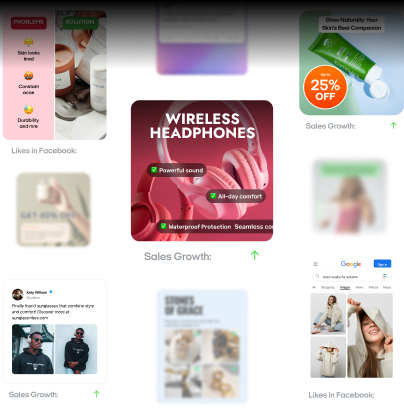UGC video ads in 2025: 6 key trends and the role of AI in advertising
Most advertisers pour money into influencer deals that barely convert. In 2025, user-generated content video ads break away from the pack — because real people, not pricey spokesmodels, share the kind of authentic stories that prompt real sales.
Current HubSpot data reveals that 56% of shoppers discover products through friends, while 79% say UGC is 9.8 times more effective than influencer endorsements according to Business Insider.
This growing emphasis on authenticity is enhanced by AI-powered video editing, real-time performance analytics, and AR/VR-driven experiences, from virtual product try-ons to interactive social commerce videos. Technologies help brands scale UGC while keeping it personal and engaging, fueling digital word-of-mouth.
If you’re aiming to future-proof your digital ad strategy, understanding the future of UGC video ads is essential. In the sections ahead, we’ll explore emerging trends, ethical considerations, and actionable tactics to make everyday creators your most valuable marketing asset.
What are UGC video ads?
They’re short, authentic videos created by real people, and not brands. These clips, often filmed by customers or fans, capture genuine experiences with a product or service. Unlike traditional video advertising, which leans on large budgets and scripted narratives, user-generated content advertising taps into community-driven storytelling.
Why does that matter?
Because people trust people. UGC campaigns often outperform high-budget ads, especially on social media, where authenticity cuts through the noise. In fact, in its research about UGC trends, Gartner indicates that 70% of brands plan to shift a major part of their media spending to entertainment-style placements. UGC ads feel more like peer recommendations than traditional marketing, and that difference boosts engagement.
How did UGC video ads evolve?
As a digital marketing asset, user-generated content has evolved dramatically. What started as casual posts on YouTube or Instagram now plays a central role in many brand strategies. These community-driven campaigns bring measurable ROI, like 25% of branded search results stemming from UGC links and a 29% jump in conversions for websites that showcase UGC.
Today, digital video advertising thrives on user-created content. Brands amplify these real stories to foster deeper connections, build trust and expand their reach. In a world saturated with ads, UGC video ads stand out as content that people actually want to watch, and that’s what makes them so powerful.
Why AI matters for UGC video ads
AI in UGC video ads is transforming digital marketing by merging authentic, community-driven content with powerful data-driven insights. This approach helped the user-generated content platform market surge to $4.4 billion in 2022, propelled by advertising automation and machine learning-driven personalization.
Since 92% of consumers trust user-generated content more than traditional ads, brands that embrace AI-based content creation can stand out in a crowded online space while maintaining a real sense of connection.
AI screens and personalizes your UGC clips
Modern video analytics rely on AI moderation to quickly filter out inappropriate user submissions and spotlight top-performing clips. It’s a game-changer for busy teams that can’t manually review hundreds of videos daily.
Beyond moderation, AI-powered personalization tools analyze audience age, location and viewing habits, then deliver the perfect UGC ad at the right time. This highly targeted approach fuels the same kind of trust you’d get from a friend’s recommendation, giving your community-driven content the edge it needs to resonate with viewers.
AI tools boost UGC video creation
Platforms like Zeely AI have streamlined automated content generation, often crafting up to ten UGC-style ad creatives faster then you can imagine. It even features AI avatars, providing a polished, live-action feel without the overhead of a traditional shoot.
These technologies reinforce rising UGC trends by reducing production costs and boosting volume. These are two essential factors for brands looking to keep pace with evolving consumer preferences. Meanwhile, solutions like Meta Advantage handle real-time bidding and A/B testing so marketers can pivot swiftly if engagement dips.
AI improves ad results
The big question remains: Do AI-powered tools improve video ad performance? Thanks to machine learning video optimization, the data says they do.
By evaluating elements like music, text overlays and visual pacing, AI can spot which creative combinations drive the most clicks, shares and conversions.
It also flags underperformers before they gobble up ad spend. Since user-generated content advertising is inherently more relatable than studio-produced ads, combining it with AI insights amplifies both authenticity and effectiveness.
Moving forward with AI in your UGC campaigns
When it comes to AI in UGC video ads, brands aren’t just chasing trends, they’re building the future of digital marketing. They perfect each phase, starting from AI moderation to automated content generation to machine learning video optimization.
You also can create campaigns that feel personal yet are precisely targeted. It’s a winning mix: real human stories backed by data-driven strategies that drive higher engagement, stronger conversions and a lasting competitive edge.
Key trends shaping UGC video ads in 2025
What are the top trends for UGC video ads in 2025? They revolve around quick-hit videos, AR/VR interactivity, shoppable features, and deeper personalization, each driven by community-driven content and machine learning-driven insights.
As a small business owner, you can tap these trends without breaking the bank, thanks to mobile-first video strategies and user-friendly editing tools. HubSpot suggests that low-production UGC often outperforms polished ads because people value relatability over perfection, giving smaller brands a genuine edge.
Short UGC videos grab attention fast
Short-form clips, often under 10 seconds, dominate platforms like TikTok, Instagram Reels, and YouTube Shorts. These vertical video formats feel genuine because they highlight everyday people rather than polished studio shoots.
In fact, recent data shows that UGC videos on TikTok are 22% more effective than branded content, underscoring the power of authenticity. Chipotle’s #GuacDance Challenge racked up 250 million views, while DoorDash repurposed simple cooking clips into shoppable video ads, boosting app downloads by 45%.
By integrating fun music, simple editing, and real-user testimonials, brands engage viewers who crave authenticity.
AR makes UGC videos come alive
How does AR improve user engagement in video ads? It overlays digital elements onto real-world settings, letting people “try on” or customize products instantly. Starbucks used AR filters for its #RedCupContest, letting fans design virtual holiday cups.
Smaller brands can follow suit by creating AR effects that showcase a new product line in a playful, interactive way. The goal is to integrate authenticity with immersive tech, turning passive viewers into active participants.
Real voices outshine big budgets
Raw, community-driven content consistently outperforms big-budget campaigns because it speaks to real problems and experiences. Warby Parker’s Home Try-On campaign used honest feedback to boost buyer confidence by 50%.
Photo source: Business Insider
According to Forbes, UGC campaigns often outperform 6- or 7-figure ads thanks to their genuine relatability. Smaller companies can leverage micro-influencers with loyal fan bases to expand their reach, without paying celebrity-level rates. Data shows 44% of consumers prefer purchasing directly from a UGC clip, proving that genuine storytelling can drive serious results.
Turning views into instant purchases
Among the biggest UGC video trends 2025 is the rise of shoppable video ads, which merge social commerce and user-generated clips. By embedding clickable product tags, brands see up to a 70% jump in conversions.
Imagine a real customer modeling your handmade jewelry, then letting viewers tap “Buy Now.” This mobile-first video strategy removes friction from the buying process, combining relatable content with instant checkout to engage audiences at the perfect moment.
Personalizing UGC on every platform
TikTok and Instagram thrive on viral dances and vertical video formats, while YouTube excels at in-depth tutorials that can generate 10x more engagement than short clips. Some brands even adapt user footage for Connected TV spots, capturing viewers on the big screen.
The common thread is machine learning-driven personalization, which identifies which themes and styles resonate best with each segment. Lululemon’s #TheSweatLife campaign localized workout videos across global markets, proving that regionalized UGC can optimize relevance and success.
Where does all this lead?
By combining AR in UGC video ads, bite-sized clips, shoppable video ads, and data-backed personalization, you can keep your brand’s marketing fresh and authentic. The best part? None of this requires Hollywood-level budgets.
From micro-influencer collaborations to modular UGC re-edits, UGC video ads let you integrate emerging tech with real customer stories, ensuring your messaging remains human, engaging, and effective. And as AI tools become more accessible, these trends will only get easier to implement.
Staying legal and honest with UGC video ads in 2025
Have you ever worried that UGC video ads might cross a legal line or damage your brand’s credibility? Understanding UGC compliance laws and regulatory considerations for UGC is the best way to avoid trouble, especially when using AI-enhanced user videos or automated content tools.
By being transparent about permissions, edits and data usage, you’ll keep your audience’s trust while meeting key legal requirements.
Spotting legal risks in 2025
Always start with user content permissions. If someone appears in a video or supplies footage, you need their consent, especially when minors are involved. This also means securing rights clearance for any logos, music or trademarked elements in their clip.
Different regions enforce different regulatory considerations for UGC video ads, from GDPR in the EU to the CCPA in California, so stay alert to local laws. Being upfront about how you’ll track or store data protects both you and your viewers.
Imagine you’re a local bakery running a “Customer Taste Test” campaign. You gather video clips showing customers’ first bites of your new cupcake. Before using these videos in ads, you’d get a simple written or digital OK for each clip, clarifying any AI enhancements. This helps you handle community-submitted video compliance the right way, and shows your fans you respect their content.
Is AI-generated UGC ethically acceptable?
Yes, but only if you’re transparent. Ethical UGC ads mean telling people when AI tools modify or create content. Don’t over-edit someone’s words or heavily alter their appearance. For example, Zeely AI creates scripts automatically for ad videos. These scripts include a short message about the product, its benefits, and a call to action. But the important thing is that they don’t talk like a real person sharing their experience. Instead, they stay neutral.
For example, instead of “I use this app, and it has helped me a lot!” Zeely’s AI will create “This app helps business owners launch ads easily, even without experience.”
Viewers should know whether a clip reflects genuine feedback or an AI-generated UGC twist. That honesty builds credibility, which matters even more if you’re a small business aiming to stand out.
How to keep UGC ads fair and trustworthy
Clarity is the key. If creators receive freebies or payment, make that public. The Federal Trade Commission and other agencies demand disclosure for any material brand–creator relationship. When working with micro-influencers, be sure your disclaimers are easy to spot. This helps you follow UGC compliance laws and strengthen consumer trust.
By applying these regulatory considerations for UGC, you’ll create ads that honor user content rights while staying within the law.
Next up, we’ll look at brands that mastered these guidelines, proving you can protect your audience, follow UGC video ads legal requirements, and still produce amazing campaigns.
Real-life case studies with UGC ads
Now that we’ve covered ethical guidelines for UGC campaigns, let’s see these principles in action. Below, you’ll find UGC case studies and examples of effective UGC campaigns in advertising that illustrate how community-driven content, micro-influencer power, and AI all come together.
These successful UGC campaigns prove that authenticity often outperforms polished ads, if you execute with clear goals and transparent communication.
Sugar Factory: turning every table into a photo op
Sugar Factory is famous for its over-the-top milkshakes, candy cocktails and colorful decor, so it’s no surprise they’re among the most Instagrammed restaurants in America.
By creating a camera-ready atmosphere, Sugar Factory sparks organic brand storytelling in video ads and photos. Traditional marketing can’t compete with the genuine excitement of real customer video testimonials, and it costs the restaurant almost nothing.
Chewy: pets, boxes, and adorable UGC
Online pet retailer Chewy taps into cuteness overload by encouraging customers to post snapshots or short videos of their pets playing with Chewy shipping boxes. Then Chewy reposts the best clips on social media, fueling more community-driven video content.
Seeing real cats and dogs enjoying Chewy’s products reassures skeptical buyers that they’re getting something worthwhile. And because fans create the ads themselves, Chewy gains a constant stream of user-generated marketing, without spending celebrity-level budgets.
Photo source: Chewy
RedBalloon: how AI supercharges UGC
While micro-influencers and everyday fans drive plenty of brand buzz, RedBalloon shows how AI can supercharge successful UGC campaigns too.
They reportedly optimized 6,400+ keywords in 24 hours, cutting customer acquisition costs by 25% and boosting Facebook conversions by 751%. Though their example isn’t built around quirky milkshakes or furry pets, it proves that merging impactful UGC campaigns with strategic keyword targeting can yield massive reach fast.
What your brand can learn
- Offer a genuine reason for people to share: fun experiences, freebies, or cute moments
- Make it effortless for fans to post content, using clear calls to action on packaging, receipts or social media
- Leverage micro-influencers for relatable endorsements, especially if you want brand storytelling in video ads without the cost of big-name spokespeople
- Use AI insights to refine campaign strategies, expand keywords, and optimize ad placements — no matter your niche
These UGC case studies reveal that user-generated content, supported by micro-influencers and AI-driven targeting, can capture audiences in ways polished campaigns cannot. In the next section, we’ll wrap up with future-facing insights on how to sustain these efforts in an ever-evolving marketing world.
Wrapping up: where UGC video ads are heading
The future of UGC video ads is more immersive, interactive, and machine learning-driven than ever. As these upcoming trends in advertising, like AR-enabled short videos, micro-influencer partnerships, and AI integration.
Gain momentum, viewers won’t just watch your campaigns; they’ll co-create them. This shift from passive viewing to authentic engagement means real-time brand participation and immersive experiences will define UGC video ad predictions in the years ahead.
Ultimately, UGC video ads thrive on real stories, interactive content, and shared ownership. Mix genuine user voices with advanced tools, such as machine learning-driven analytics or VR product demos, to keep marketing fresh and foster deeper connections.
When you follow these future marketing trends, you won’t just keep up with consumer expectations — you’ll help shape the next wave of brand storytelling.
Also recommended



